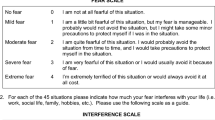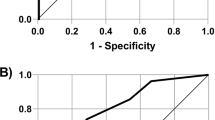Abstract
The present article reports on the development and validation of two self-report instruments designed to assess the symptoms and cognitions associated with panic attacks. The Panic Attack Symptoms Questionnaire (PASQ) as well as the Panic Attack Cognitions Questionnaire (PACQ) successfully differentiated a group of anxiety-disordered individuals with panic attacks from a group of anxiety-disordered individuals without panic attacks. Reliability estimates based on Cronbach's alpha were adequate, and two discriminant functions designed to determine whether each of these questionnaires contributed uniquely to the separation of individuals with and without panic attacks beyond that provided by standard measures of anxiety and depression supported the validity of these questionnaires. The PASQ and PACQ appear to be useful vehicles for assessing the presence and severity of panic attacks.
Similar content being viewed by others
References
American Psychiatrie Association (1980).Diagnostic and statistical manual of mental disorders (3rd Ed.). Washington, DC: APA.
American Psychiatrie Association (1987).Diagnostic and statistical manual of mental disorders (3rd Ed., revised). Washington, DC: APA.
Barlow, D., Vermilyea, J., Blanchard, E., Vermilyea, B., DiNardo, P., & Cerny, J. (1985). The phenomenon of panic.Journal of Abnormal Psychology, 94, 320–328.
Cameron, O. G., Thyer, B. A., Neese, R. M., & Curtis, G. C. (1986). Symptom profiles of DSM-III anxiety disorders.American Journal of Psychiatry, 143, 1132–1137.
Chambless, D., Caputo, G., Bright, P., & Gallagher, R. (1984). Assessment of fear in agoraphobics: The body sensation questionnaire and the agoraphobic cognitions questionnaire.Journal of Consulting and Clinical Psychology, 52, 1080–1087.
DiNardo, P., O'Brien, G., Barlow, D., Waddell, M., & Blanchard, E. (1983). Reliability of DSM-III anxiety disorder categories using a new structured interview.Archives of General Psychiatry, 40, 1070–1074.
Hibbert, G. (1984). Ideational components of anxiety: Their origin and content.British Journal of Psychiatry, 144, 618–624.
Keppel, G. (1982).Design and analysis: A researcher's handbook. New Jersey: Prentice Hall.
Sanderson, W. C., & Barlow, D. H. (1986).A description of the subcategories of the DSM-III. Revised category of Panic Disorder: Characteristics of 100 patients with different levels of avoidance. Paper presented at the meeting of the Association of the Advancement of Behavior Therapy, Chicago.
Speilberger, C., Gorsuch, R., Lushene, R., Vagg, P., & Jacobs, G. (1983).Manual for the STAI. Palo Alto: Consulting Psychologists Press.
Thyer, B. A., & Himle, J. (1987). Phobic anxiety and panic anxiety: How do they differ?Journal of Anxiety Disorders, 1, 59–67.
Zung, W. W. K. (1965). A self-rating depression scale.Archives of General Psychiatry, 12, 63–70.
Author information
Authors and Affiliations
Rights and permissions
About this article
Cite this article
Clum, G.A., Broyles, S., Borden, J. et al. Validity and reliability of the panic attack symptoms and cognitions questionnaires. J Psychopathol Behav Assess 12, 233–245 (1990). https://doi.org/10.1007/BF00960620
Issue Date:
DOI: https://doi.org/10.1007/BF00960620




